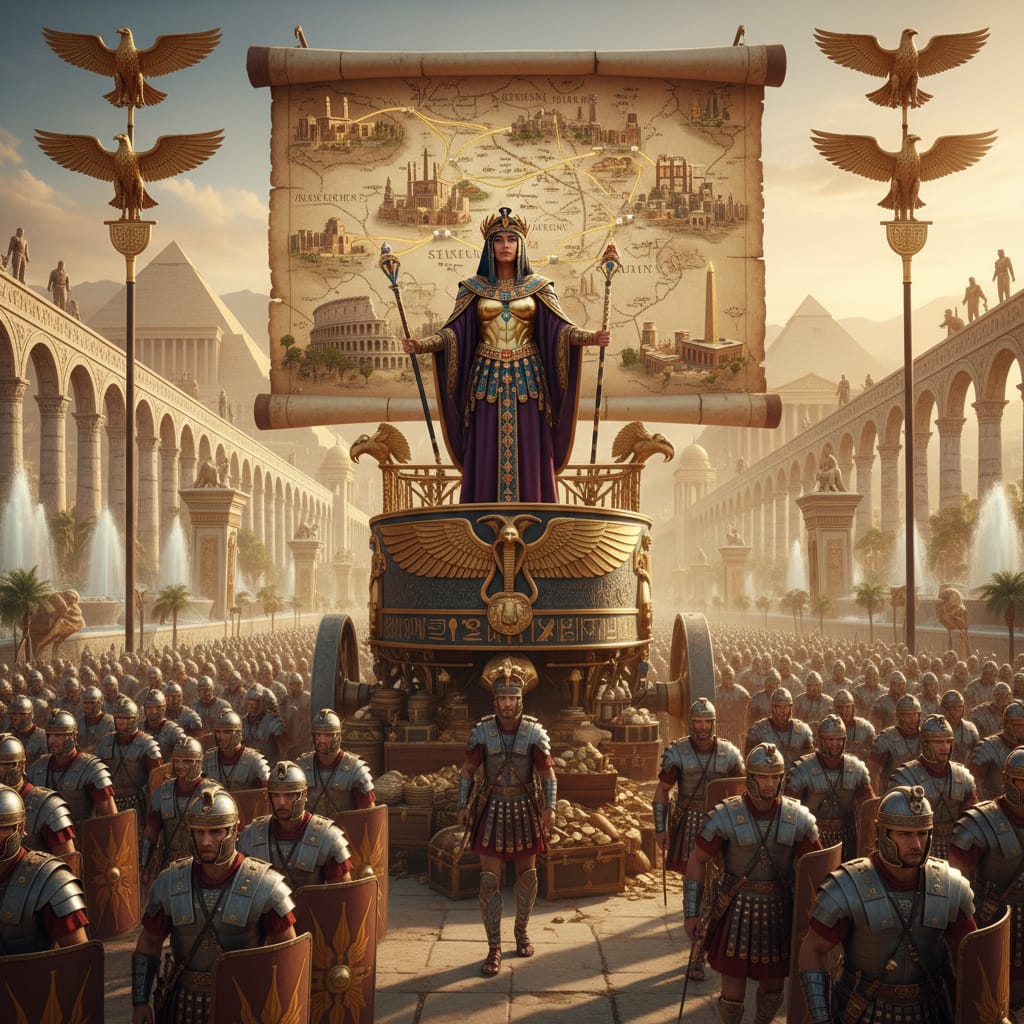In the grand tapestry of history, few what-ifs are as tantalizing as the fusion of two ancient powerhouses. What if the strategic brilliance and economic acumen of Egypt’s Cleopatra were at the helm of the Roman war machine? In the world of Civilization 6, this is a fascinating thought experiment. While not a playable combination in the standard game, analyzing this hypothetical scenario reveals a potential for a civilization of unparalleled economic and military might. This guide delves deep into the strategic implications of Cleopatra leading the Roman Empire, a combination that could dominate the world stage in ways neither civilization could alone.
The Synergies: A Perfect Union of Gold and Iron
The core of this hypothetical combination lies in the powerful synergy between Cleopatra’s leader abilities and Rome’s unique civilization traits. Cleopatra’s “Mediterranean’s Bride” ability, which grants bonus gold from trade routes, combined with Rome’s “All Roads Lead to Rome,” which provides a free trading post and road connection in every new city, creates an economic engine of unprecedented power. From the very first turn, this civilization would be geared for massive expansion and economic dominance.
Early Game: An Unstoppable Expansion
According to the player community, the early game is where this combination would be most devastating. Rome’s “Trajan’s Column” ability, granting a free Monument in every city, provides a significant cultural boost from the outset. This allows for rapid progression through the civic tree, unlocking key policies and governments far sooner than other civilizations. When combined with Cleopatra’s economic prowess, this early cultural advantage can be leveraged to secure a dominant position on the map.
A popular strategy is to focus on rapid expansion, founding new cities as quickly as possible. Each new city would instantly benefit from a free road to the capital, a free trading post, and a free Monument. This trifecta of bonuses means that new cities are immediately productive and integrated into the empire. The instant road connection facilitates trade and troop movement, while the trading post sets the stage for Cleopatra’s trade-focused abilities to shine.
The Economic Engine: Fueling the Roman War Machine
Many professional gamers suggest that the true power of this combination lies in its economic potential. Cleopatra’s “Mediterranean’s Bride” ability, which provides +2 Gold for every trade route to another civilization and +2 Gold from every trade route from another civilization, would be supercharged by Rome’s infrastructure. With a vast network of cities, each with a free trading post, the potential for generating massive amounts of gold is staggering.
Analysis on forums shows that a player could realistically field a vast network of trade routes by the Classical Era, generating hundreds of gold per turn. This immense wealth could be used to fund a powerful military, purchase buildings and districts, and patronize Great People. The ability to simply buy what is needed, when it is needed, would give this civilization a significant advantage over its rivals.
Military Dominance: The Gilded Legion
While the economic potential is undeniable, the military implications of this combination are equally formidable. Rome’s unique unit, the Legion, is one of the most powerful early-game units in Civilization 6. It is stronger than the Swordsman it replaces and has the unique ability to build a Roman Fort, a powerful defensive improvement.
A Professional Army, Paid in Gold
A popular strategy is to use the massive gold income generated by Cleopatra’s trade routes to fund a large, professional army of Legions. This would allow for a sustained campaign of early aggression, conquering neighboring civilizations and city-states with ease. The ability to purchase Legions outright, rather than relying on production, would mean that the army could be replenished quickly, maintaining constant pressure on the enemy.
Furthermore, the free road network provided by “All Roads Lead to Rome” would allow for rapid deployment of troops to any part of the empire. This strategic mobility would be a significant advantage, allowing for quick responses to threats and the ability to launch surprise attacks on multiple fronts.
The Egyptian-Roman Legion: A Tactical Analysis
The Legion’s ability to build Roman Forts would also be enhanced by this combination. A well-placed network of forts could be used to secure borders, protect valuable resources, and create defensive chokepoints. The gold generated by trade could be used to purchase builders to construct these forts, further enhancing the defensive capabilities of the empire.
Many professional gamers suggest that a key tactic would be to use the Legions to “chop” out wonders and districts. The Legion’s build charge can be used to clear forests and rainforests, providing a significant production boost. This, combined with the gold to purchase the remaining production, would allow for the construction of key wonders and districts in record time.
A Golden Age of Culture and Science
While the military and economic potential of this combination is clear, it would also be a powerhouse of culture and science. The free Monuments in every city provide a solid foundation for cultural growth, and the massive gold income can be used to purchase cultural buildings and Great Works.
Patron of the Arts and Sciences
A popular strategy is to use the gold generated by trade to patronize Great Artists, Musicians, and Writers. This would allow for the rapid accumulation of Great Works, leading to a cultural victory. The ability to simply buy Great People would give this civilization a significant advantage in the race for cultural dominance.
Similarly, the gold could be used to purchase scientific buildings and universities, accelerating progress through the technology tree. The ability to maintain a technological advantage over other civilizations would further enhance the military and economic dominance of this combination.
The Great Library of Alexandria, in Rome
Analysis on forums shows that this civilization would be a natural wonder-building powerhouse. The combination of Rome’s production capabilities and Cleopatra’s gold would allow for the construction of almost any wonder. The Great Library, the Colossus, the Terracotta Army – all would be within reach. The ability to secure key wonders would provide a significant and lasting advantage throughout the game.
Mid-Game Transition: From Legion to Legionary Cohort
As the game progresses into the medieval and renaissance eras, the dominance of the Legion will begin to wane. However, the economic and infrastructural advantages of this combination will continue to provide a significant edge. The vast wealth accumulated in the early game can be used to upgrade the military, purchase advanced units, and continue to expand the empire.
A Global Trading Empire
According to the player community, the mid-game is where the focus should shift from military conquest to economic and diplomatic dominance. The vast network of trade routes established in the early game can be expanded, creating a global trading empire. The gold generated by this empire can be used to influence city-states, bribe other civilizations, and control the World Congress.
A popular strategy is to focus on a diplomatic victory. The ability to generate massive amounts of diplomatic favor through trade and alliances would make this a very viable path to victory. The gold could be used to win every diplomatic victory point competition, securing a peaceful, yet dominant, victory.
The Power of the Purse
Many professional gamers suggest that the true strength of this combination in the mid-game is the ability to dictate the flow of the game through economic power. The ability to fund proxy wars, embargo rival civilizations, and prop up friendly ones would give this civilization a level of global influence that would be difficult to counter.
Late Game: A New Roman Golden Age
In the late game, the economic and technological advantages accumulated throughout the game would come to fruition. This civilization would be a global superpower, capable of achieving any victory condition it chooses.
A Technological Behemoth
Analysis on forums shows that a science victory would be a natural fit for this combination. The massive population and production centers, fueled by trade and infrastructure, would be ideal for constructing the spaceports and completing the space race projects. The gold reserves could be used to purchase any missing components, ensuring a swift and decisive victory.
A Cultural Renaissance
A cultural victory would also be well within reach. The vast collection of Great Works, the numerous wonders, and the high population cities would generate a massive amount of tourism. The gold could be used to purchase rock bands and national parks, further boosting tourism and securing a cultural victory.
The Ultimate Power Couple
The hypothetical union of Cleopatra and Rome in Civilization 6 creates a civilization of unparalleled power and versatility. The synergy between Cleopatra’s economic prowess and Rome’s expansionist and infrastructural strengths creates an unstoppable force. From the early game’s rapid expansion and military dominance to the late game’s economic and technological supremacy, this combination would be a true titan of the ancient world. While this remains a tantalizing “what if,” the analysis of this hypothetical scenario provides valuable insights into the intricate strategies and powerful combinations that make Civilization 6 such an endlessly fascinating game. The player community agrees: if Cleopatra had led Rome, the world would have trembled.


